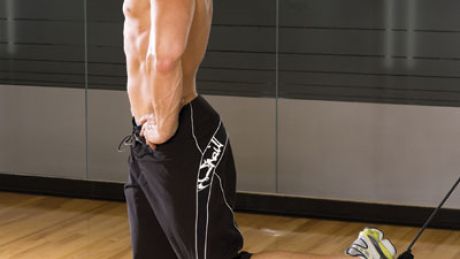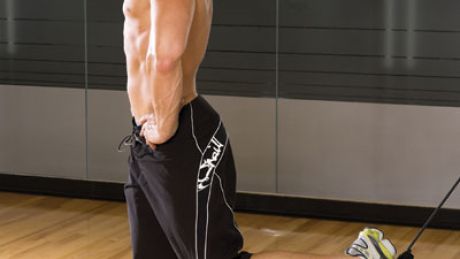Tri-Set Quads Workout
Build strength and stability in your thighs with this tri-set quads workout

In This Series
The quadriceps muscles run along the front of your thighs and you use them every time you take a step or stand up. Increasing their size and strength will improve your sporting performance, boost your ability to lift heavier weights and generally make life easier.
How to do this workout
Leave two to three days between each workout to let your muscles recover. You can do just these workouts or add them into a longer gym session. Warm up with five minutes on a rowing machine.
Complete this workout as a tri-set, which means one set each of the three exercises performed back to back without a rest. Use a spotter for the squats. Rest for one minute to 90 seconds between sets.
1. Jumping unweighted squat
A classic squat to fire up your quads.
Sets 3 Trisets 4 Reps: 10
Target: quads
Why it works: This explosive move fires up your quads and forces them to stabilise themselves when you land, making your workout more functional in the process.
Get the Coach Newsletter
Sign up for workout ideas, training advice, reviews of the latest gear and more.
- Stand with feet slightly wider than shoulder-width apart.
- Drop into a squat, keeping your lower back neutral, your shoulders back and your eyes forward.
- Stop when your thighs are level with the floor and drive back up hard so your feet leave the ground.
2. Unilateral squat with medicine ball
A one-sided squat that builds stability.
Sets 3 Trisets 4 Reps 10
Target: quads
Why it works: This targets the muscle that stabilises your kneecap. There’s little point having bulging quads if your knees can’t support them.
- Stand holding a medicine ball in front of you.
- Bring your left leg up behind you.
- Lower yourself as far as you can, then drive back up again.
- Do ten reps on one side and swap sides on the next tri-set.
3. Unilateral stretch band leg extension
A resistance exercise using a stretch band.
Sets 3 Trisets 4 Reps 10
Target: quads
Why it works: Stretch bands are useful tools because as well as increasing strength they improve your range of motion. They have varying degrees of resistance, which means you can make your legs work harder to stabilise themselves as you get stronger.
- Anchor a light resistance stretch band behind you and stand facing away from it.
- Bend one leg and loop the stretch band around the top of your foot. Keep your shoulders back and your lower back neutral.
- Straighten your leg against the resistance of the band.
- Once your leg is straight, hold your quad tight for two seconds before lowering.

Coach is a health and fitness title. This byline is used for posting sponsored content, book extracts and the like. It is also used as a placeholder for articles published a long time ago when the original author is unclear. You can find out more about this publication and find the contact details of the editorial team on the About Us page.

